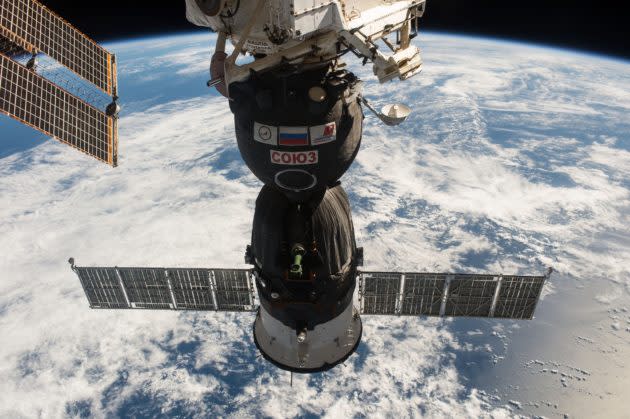Don’t panic: Space station crew works to patch up tiny air leak in docked Soyuz craft

The International Space Station’s flight controllers detected a minute pressure leak overnight, but a temporary fix was made with epoxy and a gauze wipe. The six-person crew is in no danger, NASA said.
In a status update, NASA said the leak was isolated to a hole that’s about 2 millimeters (0.07 inches) in diameter in the orbital compartment of the Soyuz MS-09’s orbital module, which is attached to Russia’s Rassvet module. “This is a section of the Soyuz that does not return to Earth,” NASA explained.
The leak rate was minuscule, and initially the crew put Kapton tape over the hole to slow the loss of pressure even further.
Troubleshooting and repair work continued. At one point, NASA astronaut Drew Feustel, who serves as the space station’s commander, counseled caution.
“I’m inclined to ask my Russian crewmates to not put the epoxy in there, because we sort of feel like we’ve got one shot at this, and if we screw it up, then the implications are [that] one of these vehicles is going home,” Feustel told Mission Control.
After some debate, Russian controllers agreed with NASA’s team to take more time to investigate the leak. Feustel said the crew was testing a plug that was held in place with tape, and a Russian crewmate reported that the results looked promising.
“There is no leak,” cosmonaut Oleg Artemyev told Russian Mission Control. “It’s good news.”
Controllers at NASA said their readings also showed that the pressure had stabilized. After monitoring the situation for the better part of an hour, the space station crew pressed a sealant-laden wipe into the leak site to firm up the temporary patch.
“Once the patching is complete, additional leak checks will be performed,” NASA said. “All station systems are stable, and the crew is in no danger as the work to develop a long-term repair continues.”
